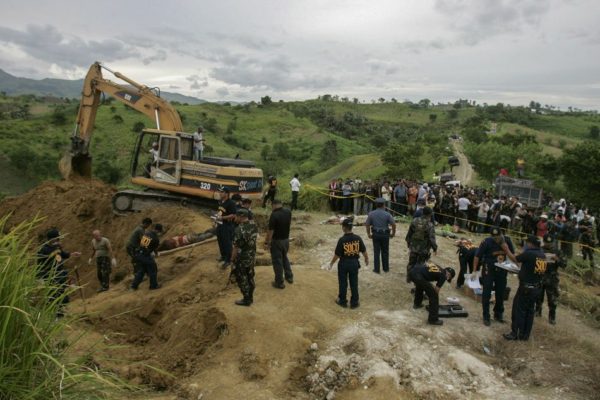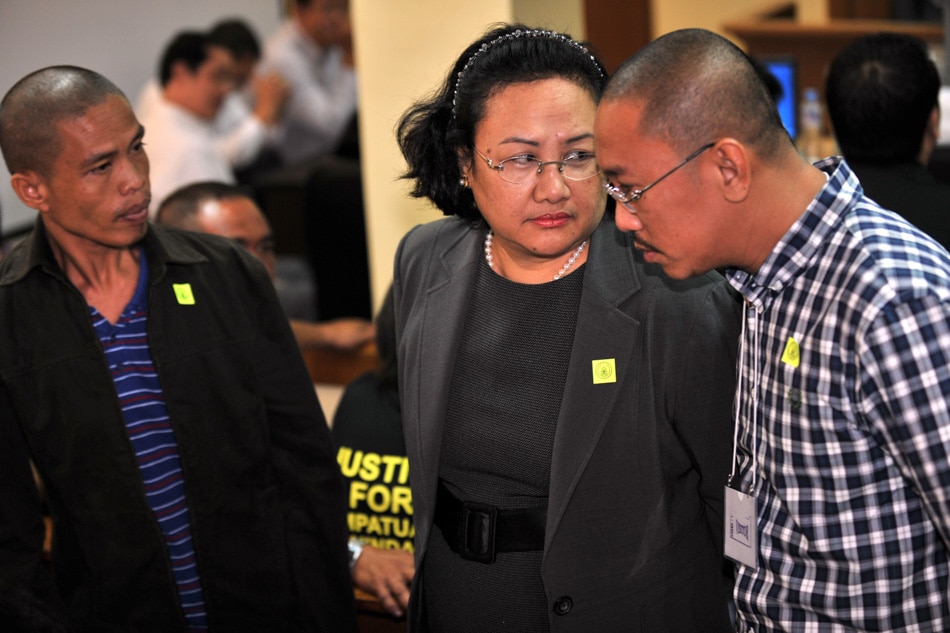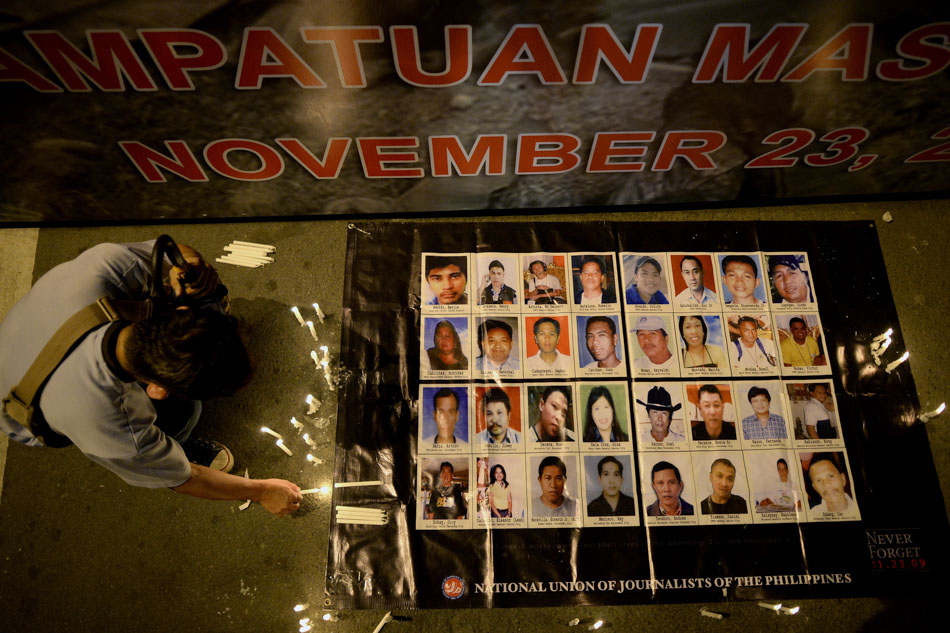In one of the meetings, Badal said Datu Unsay allegedly told his father: “Ama, kung sinumang magtangkang umagaw sa kapangyarihan natin ay papatayin natin silang lahat, lalong lalo na ang mga Mangudadatu na iyan.”
(Father, whoever attempts to wrest power from us, we’ll kill them all, especially the Mangudadatus.)
Badal also claimed he saw Datu Unsay ordering his men to stop the Mangudadatu convoy and that it was Unsay himself who shot some of the victims.
He also testified that Ampatuan Sr. instructed Unsay, through a call, to kill everyone, including members of the media.
Unsay also allegedly called up a cousin to hasten burying the victims and their vehicles upon learning that soldiers were arriving at the site.
Badal’s testimony was supported by other witnesses who corroborated different aspects of the massacre—from the planning to the execution to the cover-up.
Mangudadatu also testified receiving a phone call from his wife identifying Unsay as one of the armed men who blocked their convoy–their last conversation before she was killed.
In his defense, Datu Unsay claimed he was in the United States when the meetings supposedly happened and that he was at the municipal hall of Datu Unsay town from 8:35 a.m. to 12:30 p.m. when the killings took place.
His side also presented witnesses to discredit testimonies of others, including Saliao, except that of Badal.
Badal was never mentioned in Unsay’s memorandum, although Unsay’s lawyer had moved for the reopening of the trial last month, claiming Badal informed them through a representative that he would be recanting his testimony.
But Badal never recanted, telling the court: “There is no truth to the statement in the motion, they are all made up by the accused Unsay to delay the case.”
Instead, Unsay’s memorandum questioned the prosecution’s lack of object evidence such as the absence of a ballistics report, DNA or fingerprints, photos or videos and gunshot residues.
“Not a single piece of hard physical evidence had been presented by the prosecution linking the accused to the crime herein charged. No correlation between the perpetrator and the victims had ever been established through documentary or object evidence,” read the belatedly filed memorandum, which the court has yet to admit.
“No physical evidence to support the claim that the evidence of guilt as against the accused is beyond reasonable doubt. There is also no physical evidence that would corroborate the tales of the witnesses of the prosecution,” the memorandum further read.
For his part, Zaldy denied involvement, saying he was in Manila for a meeting with then President Gloria Macapagal Arroyo in Malacañang on the day of the massacre. Sajid, meanwhile, said he went into “reclusion” and had been avoiding his brothers and parents since he was removed as Maguindanao officer-in-charge a month before the killings.
The defense also said the prosecution failed to establish there was conspiracy among the accused.
ABS-CBN News reached out to lawyers of the Ampatuans but they declined an interview and did not issue any statement.
The prosecution, however, insisted they have presented sufficient evidence to warrant convictions.
“Verily, accused Datu Unsay’s bare denial and alibi, when raised against the direct, positive and categorical testimony of prosecution witnesses cannot prevail,” they said in their memorandum.
“As such, he miserably failed to establish his presence in another place at the time of the commission of the offense and the physical impossibility for him to be at the scene of the crime,” the prosecution said, pointing out that only 1 municipality separates the towns of Datu Unsay, where he claimed he was, and Ampatuan, where the massacre happened.
Private prosecutor Nena Santos, who represents families of 38 victims including the Mangudadatus, is confident they have presented enough evidence at least with respect to the principal accused.
“We are not sure of the 100 percent but we are sure that the principal accused will be convicted,” she said at a press conference last November 5.
WHY THE DELAY?
Santos has been handling the case since the beginning of the trial.
The murder cases will turn 10 years old by December 1 this year, counting from the time the initial batch of 25 cases were filed in a Cotabato court on December 1, 2009.
The cases have since been consolidated and moved to Quezon City due to security concerns.
Private prosecutor Gilbert Andres, one of the lawyers for some of the journalist victims, said the sheer complexity of the case accounts for the long drawn-out prosecution.
“This is really a complex case in a sense that there were 58 victims and at the start, there were even 197 accused, although bumaba na ‘yan dahil sa mga naging state witness (that has since dropped because some became state witnesses). By itself, it’s already a complicated case kasi it’s 58 times 197. That’s the number of criminal cases actually,” he told ABS-CBN News in an interview.
“But secondly also is that there has been a period where there were changes of counsels for some of the accused. That also added to the time to submit this case for decision kasi siyempre (because of course) the court will be constrained to wait. The court will be constrained, due process, for a new counsel,” he added.
Datu Unsay alone changed counsels 5 times during the course of the trial: Fortun Narvasa & Salazar, the now Presidential Spokesperson and Chief Presidential Legal Counsel Salvador Panelo, Manuel Law Office, Fortun and Santos Law Offices, and Laguatan Law Offices.
Santos, for her part, also cited the numerous motions filed and cases lodged by the accused against witnesses and even lawyers of the prosecution.
“Ang daming witnesses na tinakot, pinatay. Ang daming witnesses na pina-recant, and maraming panahon ang ginugol para i-resolve ‘yung mga pending motions ng defense na napakarami. Ito lahat, confluence of events na nagpatagal sa kaso,” she said.
(There were many witnesses threatened, killed. Many witnesses were asked to recant and a lot of time was spent to resolve the pending motions of the defense. All of these are a confluence of events which delayed the case.)
Three prosecution witnesses have been killed since the case was filed in court while others, according to Santos, have been receiving threats.
Among these witnesses is Lakmodin Saliao, a former personal assistant to the Ampatuans, whom Santos said Sajid Ampatuan allegedly threatened after the latter was released on bail in January 2015. Saliao has stuck to his testimony.
However, two prosecution witnesses—Laguidin Haron Alfonso and Thonti Lawani—recanted. Both had originally claimed they saw Unsay at the Masalay crossing just before the killings took place. They are now saying they were forced to lie allegedly due to threats to their families.
Andres’ co-counsel Harry Roque, a former Presidential spokesperson, urged government to improve and speed up the process for accepting witnesses in the witness protection program.
“Huwag na nating patagalin ‘yung proseso ng pagtanggap ng mga state witnesses kasi kaya nga nila kailangan ng proteksyon, may banta sa buhay nila,” he said.
(Let’s not prolong the process in accepting state witnesses because threats to their lives is the very reason why they need protection.)
He blamed the court for not implementing guidelines issued by the Supreme Court in 2013 to expedite the trial.
Under the rules, the parties were required to submit judicial affidavits instead of direct testimonies and the judge was also authorized to issue separate decisions for those that are ripe for resolution.
“Dapat pinatupad ‘yung mga innovations na sinangguni namin at sinang-ayunan naman ng Supreme Court. Ang inaasahan namin, ‘yung first in, first out, ipapatupad. Dapat hindi sabay-sabay ‘yung promulgation. ‘Yun mga natapos na ang presentation of evidence, dapat binasahan na,” he said.
(The innovations that we suggested and the Supreme Court approved should have been implemented. We expected a first in, first out policy, not joint promulgation. Those who have presented evidence should have already been sentenced.)
“Pero bagama’t ito’y sinang-ayunan nga ng ating Kataas-taasang Hukuman, hindi naman napatupad ng regional trial court. Inantay pa rin na matapos ang lahat ng ebidensiya laban sa lahat ng nasasakdal bago magkakaroon ng promulgation. Natural, ganito katagal ang aabutin,” he added.
(Despite the Supreme Court’s approval, the regional trial court did not implement it. It waited for everyone to finish presenting all the evidence against all the accused before holding a promulgation. That’s why it has lasted this long.)
THE LONG WAIT FOR JUSTICE
“We’re really hoping that it will already be decided soon,” Andres said.
“On the part of our clients, they’re really awaiting the decision, whatever the decision is. So they just want that para magkaroon na na rin sila ng closure at para magkaroon sila ng sense of justice (so that they can have closure and a sense of justice),” he added, explaining that most of the families of the victims lost breadwinners and have to live with the trauma.
Santos warned that although the influence of the Ampatuan family in the area has significantly waned since the massacre, there are still areas where they hold power.
“For as long as there will be no strong contender against them, they might rise again. So it’s up to the people of Maguindanao to choose the right leaders so that the Maguindanao massacre will never be repeated,” she said.
But the bigger concern is the implication of the outcome of the Maguindanao massacre murder case on the state of press freedom in the country.
“If nobody gets to jail for killing journalists, what will happen to press freedom? Nada, it’s dead,” she said.
Mangudadatu has vowed to resign if the Ampatuans are not convicted.
Meanwhile, the Quezon City court has yet to rule on Datu Unsay’s motion to admit his memorandum and set the date for the verdict.
Until then, families of the 58 massacre victims continue to wait for long delayed justice.









